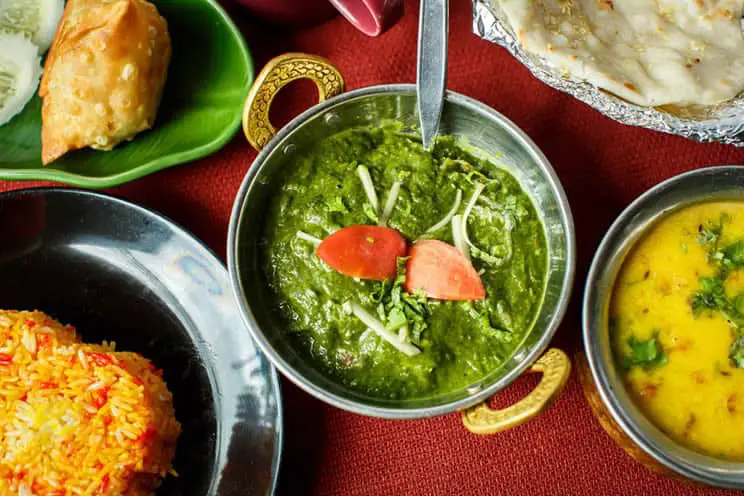
When it comes to weddings, there’s the attire, venue, guest list, and last but certainly not least, the food, of course! Given that food is central to just about every culture, there is, it’s no surprise that this element is one of the most important in any wedding.
When it comes to Hindu weddings, they are no exception, as food plays a major role in the entire ceremony. Hindu weddings are known for their lavishness, traditional customs, and even more traditional ceremonies, lasting about three days. With so much celebrating going on, food is not only a necessity at a Hindu wedding for keeping guests satisfied, it’s also a way for the wedding party to show off.
15 traditional foods served at Hindu weddings include:
- Chaat
- Pachadi
- Sabzi
- Samosas
- Dal
- Sambar
- Naan
- Paneer
- Aloo
- Rice
- Dosa
- Non-Vegetarian Dishes
- Mithai
- Payasam
- Rasavalli
- Curry
Although there is no specific traditional spread that is served at a Hindu wedding, there are a variety of traditional dishes that are typically served. From all the curries you could possibly think to piles of naan, anyone attending a Hindu wedding is sure to leave with a memorable experience and a full stomach!
What Food Is Served At A Hindu Wedding?
The food menu at a Hindu wedding is not exactly set in stone as one could easily assume compared to that of a traditional wedding in the U.S. A typical American wedding reception consists of staple dinner entrée options like steak, chicken, and fish, intricately nestled between a starter salad, and followed by something sweet.
Hint, hint: the “something sweet” is traditionally a decadent wedding cake! However, over the past decade or so, the traditional wedding spread has evolved to include non-traditional wedding foods, decadent spreads, and so much more than just your average wedding cake. The same goes for the foods served at Hindu weddings.
The majority of food served at a Hindu wedding does include traditional Indian staples such as naan, a type of flatbread, tikka masala, lots and lots of curries, and so much more.
The menu for a Hindu wedding changes ever so constantly depending on the preference of the wedding party as well as any dietary restrictions and culturally specific needs.
South Indian Hindu vs. North Indian Hindu
Similar to how a wedding on the East coast might differ from a wedding on the West coast in America, North Indian and South Indian Hindu weddings tend to differ in the foods that are typically served at each one. The foods served at a Hindu wedding do vary from wedding to wedding based on cultural and religious background.
“When served in the U.S., though, the food tends to be North Indian, meaning you’ll see a spread of naan (a flatbread) with different curries, samosas (savory pastries with spiced meats or vegetables), pakoras (fritters) and a dessert display, which typically includes cake, kulfi (Indian ice cream) and decorated sweets made from nuts.”
Source: What To Expect at an Indian Wedding
For instance, while a North Indian Hindu wedding might serve foods such as chicken or seafood curries, a South Indian Hindu wedding will mostly serve foods that are completely vegetarian and plant-based.
Another factor to consider surrounding dietary restrictions based on cultural and religious practices is the debate around vegetarianism in Hinduism. Hindus are not strictly vegetarian. However, vegetarianism in Hinduism has become common quite recently.
This stems from when the caste system was at its strongest, and vegetarianism was enforced on lower castes. As of now, many South Hindus still remain vegetarians, given that much of South Indian food is indeed plant-based. Furthermore, much of South Indian is predominantly Hindu.
Regardless of the region the wedding party originates from, many of the dishes remain the same. However, substitutions are made where necessary. South Indian Hindu weddings tend to have more food.
Chaat
Chaat refers to the array of Indian appetizers, snacks, side dishes, and spices adorning a table, similar to a buffet.
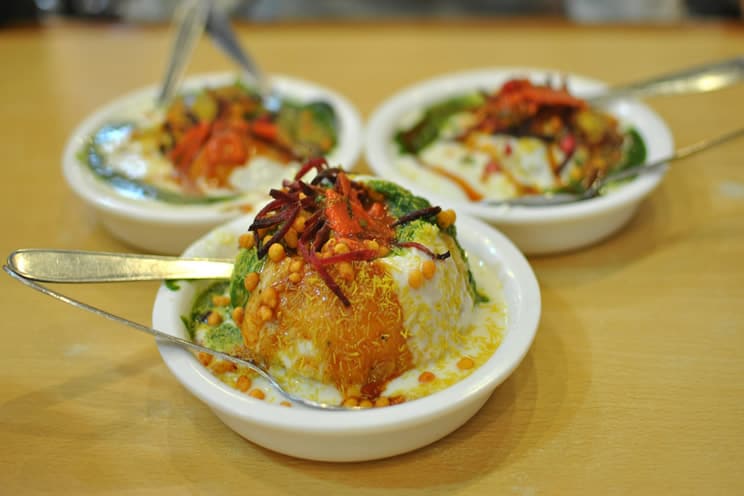
“Chaat, a term describing savory snacks in India, is a category diverse as South Asian people themselves. From aloo to tikka to bhel puri, Chaat can describe any combination of yogurt, spices, potatoes, chutney, and fried foods eaten on Indian roadsides.”
Source: The Big Fat Indian Wedding
Whether it’s a buffet of every possible dish you could imagine or an all-you-can-eat ice cream station, you can never go wrong with having an abundance of food at a wedding, and this is certainly the case with a Hindu wedding.
Imagine it, a table full of savory delights and possibly some of your favorite snacks you remember indulging in when you were younger. If you do happen to attend a Hindu wedding, the chaat table is the place where you can satisfy all of your cravings for Indian delights – guaranteed!
Think of the chaat table as the open bar of a wedding reception except instead of an endless selection of wine and spirits, there’s an endless selection of foods!
When there’s a chaat table at a Hindu wedding, the initial reaction for any food lover is to go all in, but remember, slow always wins the race. Besides, there will be plenty more food to enjoy.
Pachadi
Pachadi is a traditional dish originating from South India. It is typically served as a side dish and consists of spiced seasonal vegetables and fruit that have been pounded. Traditionally, many Indian side dishes are often accompanied by rice, and this practice would apply to pachadi, as it is often eaten along with rice and dosa.
In addition to the traditional pachadi made with pickles, there are also several other varieties of pachadi, including cucumber pachadi, which often also includes red onions and spices like coriander, and greens pachadi, which is made with roasted red chilies and sorrel leaves.
Pachadi at a Hindu wedding is not necessarily to be eaten as a main dish, but rather as a side dish or accompaniment for a grain such as rice or couscous even. Pachadi often uses seasonal vegetables and herbs, so depending on the season in which the wedding occurs, the pachadi may feature some fresh vegetables and fruits of the current season.
Sabzi
Sabzi, also often referred to as subj (sabji), is a term for an Indian vegetable dish featuring all sorts of Indian spices like turmeric and cumin, rice, tomatoes, and vegetable greens. This dish is often a big hit with South Indian Hindu weddings, as it is popular amongst vegetarians.
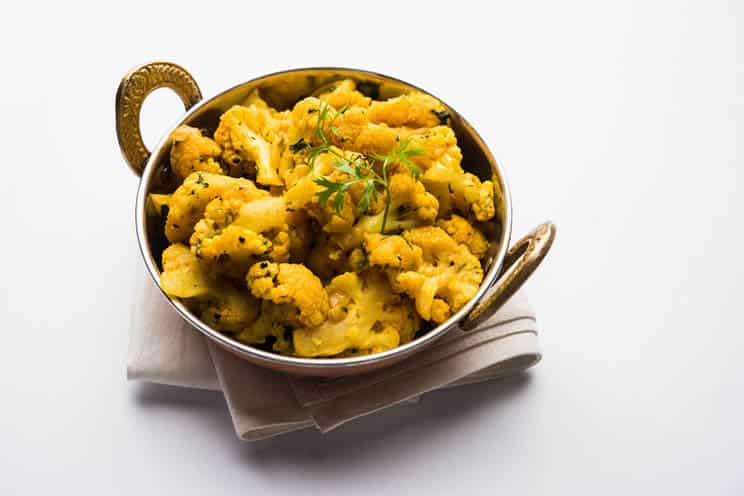
In addition to this, sabzi also tends to be a big hit for many, regardless of dietary restrictions or preferences. Sabzi can be made in several different forms, including wet, usually when cooked in gravy, dry, and as a curry.
Much of sabzi dishes can vary, considering there are over 500 combinations of the popular dish. Sabzis are typically eaten as a lunch dish and can include anything from aloo, a potato-based dish, banana, and even jackfruit.
Samosas
Much like curry, one can never go wrong with having this savory finger food at a Hindu wedding. Samosas are savory pastry pockets often filled with meat, potatoes, onion, lentils, and a blend of spices. They are a popular dish that can be served at all occasions, including a Hindu wedding.
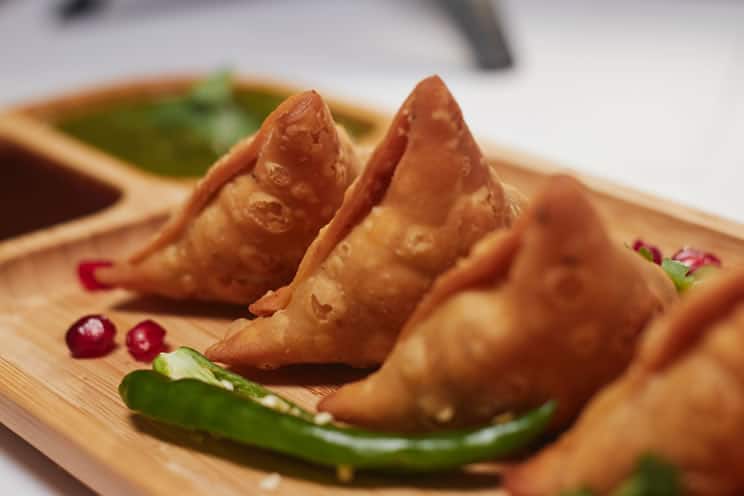
Likewise, in addition to curry, the Indian samosa is easily recognized as one of the most popular Indian foods out there. One reason for the samosa’s popularity is the flexibility behind how it can be eaten and served. Samosas can be eaten as an appetizer, entree, or a quick bite to eat, such as a snack.
Indian samosas have evolved over the many years, and several cultures have now adopted them and formed their own version of the popular dish. The custom of eating samosas is to pair them with a freshly made chutney.
Think of chutney as a type of salsa or condiment that often features an intense kick of spice and flavor.
Dal
Indian dal, or dhal, refers to both the ingredient and the dish commonly enjoyed in Indian cuisine. The ingredient dal refers to a type of lentil, split pea, and bean that neither requires pre-soaking before cooking, while the dish refers to the soup form after the ingredients have been stewed down to create a soup or stew-like dish.
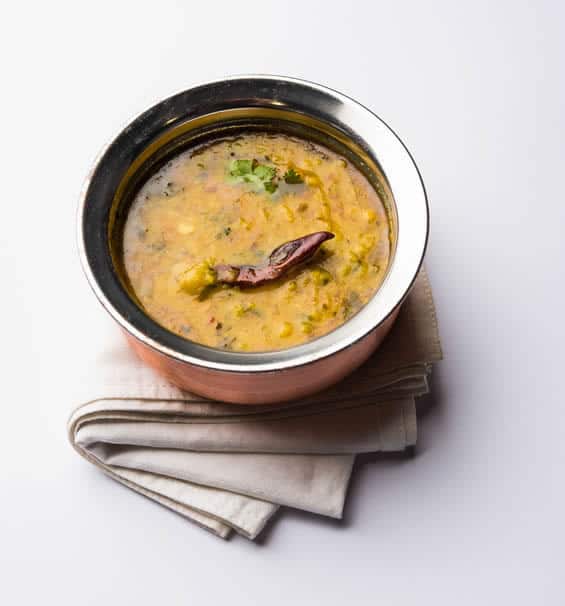
And while dal does refer to an ingredient and a dish, the Indian cuisine culture generally refers to anything that resembles a legume as simply, dal. Because of this, dal practically comes in many varieties and colors.
The process of making dal is fairly simple and does not differ according to the type of dal (ingredient). The standard dal stew or soup is made by soaking the legume seeds overnight, draining them, and then cooking them until they are tender enough to eat or to one’s liking.
Once this is completed, you are free to add any spices and extra ingredients you would like.
Sambar
Sambar is another dish hailing from South Indian and bound to be at a Hindu wedding. Sambar is a plant-based stew made with lentils, spices, and tamarind broth; a broth made from legumes. It is generally eaten as a side dish for breakfast or any meal throughout the day. It can also be eaten with rice or a rice patty such as a soft idli.
Hindu weddings are known for their lavishness and entertaining atmosphere, which means, generally speaking, there will be much dancing and socializing involved.
Surely loading up on the cake wouldn’t have its benefits of allowing you to keep with the rest of the wedding attendees, so having a sambar nearby is almost necessary.
Sambar offers much nutrition and flavor, the best of both worlds that will keep any Hindu wedding attendee on their feet for hours, and even days, to come! For more information on this popular South Indian dish and a tasty recipe, visit here.
Naan
Naan is a very popular type of bread consumed in Indian cuisine. Often leavened, softened and lightened in texture and tone, naan is a type of flatbread that closely resembles traditional breads like pita and tandoor. It is usually made with Indian white flour, which gives it the signature powdery and soft texture loved by so many.
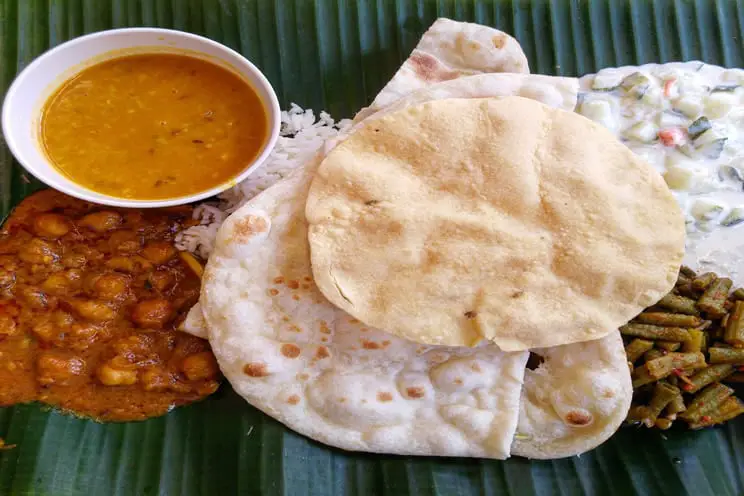
Though it can be seasoned and spiced to one’s liking, it is often adorned with nigella seeds and brushed with water, butter, or ghee, a clarified Indian butter.
“It is often seasoned with nigella seeds – black seeds with a slightly astringent flavor that can be found in Indian grocery stores and are sometimes mistakenly called ‘onion seeds,’ ‘black sesame,’ or ‘black cumin.’”
Source: The Daily Meal
Naan is typically eaten with curries and stews and is meant to act as a spoon to sop and scoop up all remnants, including vegetables and meat. Naan is often to Hindu weddings as mediocre bread rolls are to your typical American wedding, though they are as equally delicious and complimenting to any appetizer, entree, or snack.
Paneer
For all of the cheese lovers out there, there’s no guarantee that this lovely staple will be at all of the Hindu weddings, but there’s certainly a chance. Although vegetarianism and veganism are quite common in Indian culture, there are a select few that freely enjoy cheese, and especially paneer.
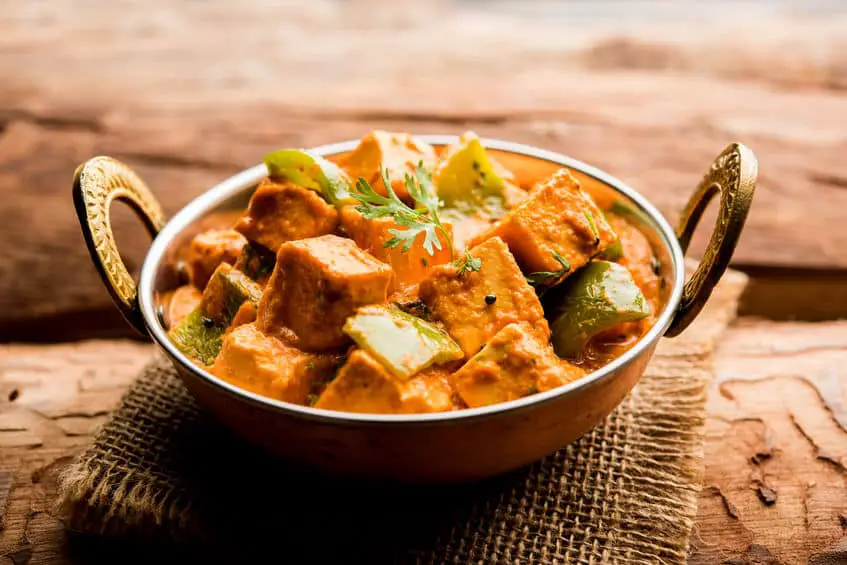
Paneer is a common type of Indian cheese made from curdled milk.
Along with the curdled milk, any sort of an acidic juice either from a vegetable or fruit such as lemon is mixed with this milk to form what is known as paneer. Even better, paneer is a cheese that is unaged, soft, and it doesn’t melt!
That’s right, it doesn’t melt. So, while adding you’re busy loading up on the tikka masala, you never have to worry about the heat from the food melting the paneer you can’t wait to indulge in. Paneer is often eaten as a snack and can be enjoyed with naan or in curries and stews as the main ingredient.
For a better look at paneer, visit here.
Aloo
Aloo is another term that can refer to both an ingredient and a dish. Aloo is a South Asian term for potatoes, and when combined with terms such as gobi, gosht, and mutter, to name a few, it is considered to be a dish.
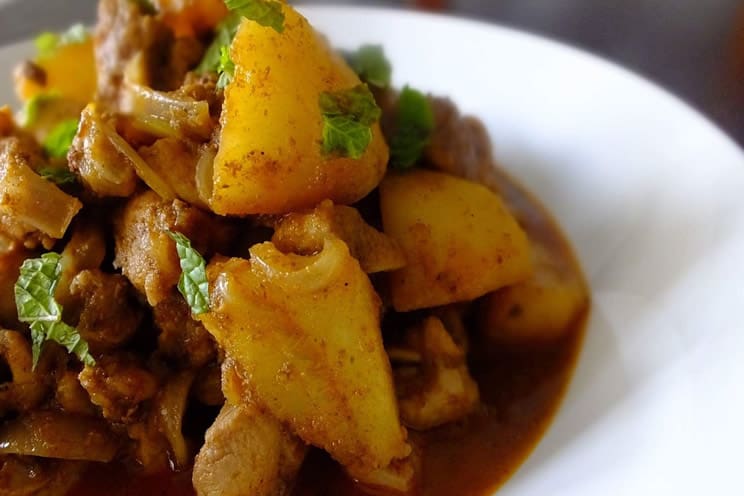
At many Hindu weddings, it is custom to serve at least one type of aloo item or dish, whether it’s a curry or completely vegetable-based dish.
An aloo dish is best known for adding fullness to the meal and gaining the approval of any older wedding attendees in search of a dish that is full of substance. Any type of aloo dish is typically served warm and eaten as a side dish.
Some other types of aloo dishes include aloo gobi, a potato and cauliflower mixture, aloo paratha, naan stuffed with mashed potatoes, and saag aloo, fried potatoes in a spinach curry.
Rice
Considering rice is a staple in much of Asian cuisine, it is a definite guarantee that it will be served at a Hindu wedding. Think of rice as the root of every Indian’s diet, basically; it plays a major role. There’s no limit to the varieties of rice that may be served either, as there are several types of Indian rice as well as ways in which they can be prepared.
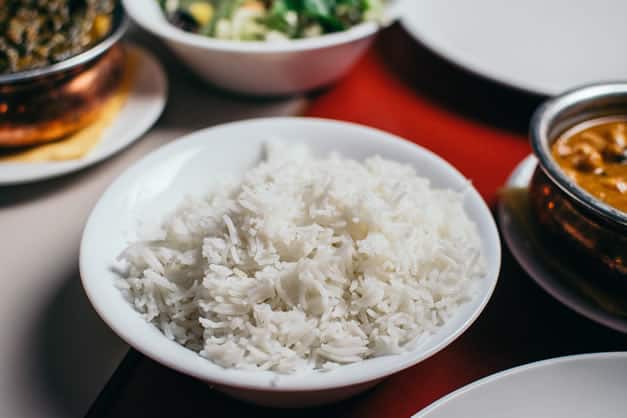
Basmati and white rice are two of the most common types of rice in Indian cuisine and can be eaten with just about any main or side dish, appetizer, snack, and even some desserts. In addition to being a dish all on its own, rice is also the main ingredient in many dishes, including dal in particular.
Dosa
Getting back to rice, dosa is just another example of the many ways in which rice can be used. Dosa is a South Indian food consisting of a rice pancake, almost resembling a crepe. Dosa is relatively thin and is made from a fermented batter and black gram, a type of bean grown in South Asia.
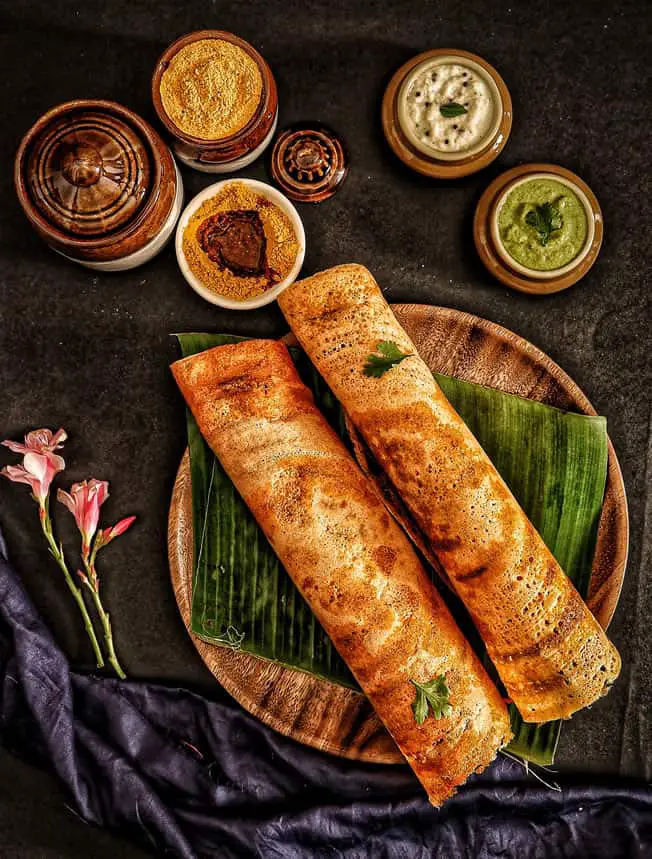
Once these ingredients have fermented, the batter begins to thicken once water is added to the mixture. This mixture is then ladled onto a tava, a hot griddle that has been greased with ghee or oil and spread to create a thin layer.
Once the thin layer begins to heat up lightly, the pancake is formed, and the dosa is ready to eat.
Dosa is typically treated like naan and used as a utensil when eating certain dishes like curries and stews. Sometimes it is also filled with vegetables and eaten with a side dish like those mentioned previously.
Non-Vegetarian Dishes
Hindu weddings tend to traditionally be vegetarian affairs however, in some places especially outside of India, meat may be served. As long as the meat is not served in holy places like the temple or any building owned and operated by the temple, then meat is a possible dish.
Chicken Tikka Masala
Chicken tikka masala is an absolute favorite among many North Indian Hindu weddings. While the exact origins of chicken tikka masala are still disputed, there’s no doubt that there isn’t some type of Indian influence on the beloved classic dish.
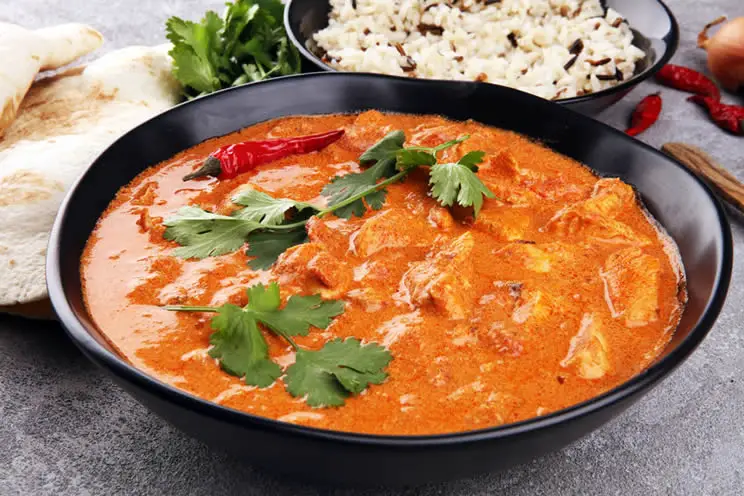
Likewise, it’s more than likely that many would rather flock to this dish than turn a blind eye to it; it’s just that good!
Chicken tikka masala is a curry dish featuring marinated chunks of roasted chicken smothered in an orange curry sauce. The reason for not doubting the Indian influences of this popular dish is because of its main ingredient: chicken tikka. Chicken tikka is just one of the many Indian staples known to the national cuisine.
It is a chicken dish often consisting of boneless chicken marinated in a rich blend of Indian spices and yogurt.
This is the base of the chicken tikka masala dish, and once the marinated chicken has finished cooking, it is then sliced into chunks and mixed into a creamy orange-colored curry sauce made with coconut cream, masala spices, and tomatoes.
Lemon Chicken
Also, another dish you would typically see at a North Indian Hindu wedding, lemon chicken, and particularly, Punjabi lemon chicken, is another showstopper for all attendees. This rich, decadent dish is great for any type of meat-eater, even the pickiest of eaters, just be ready to deal with the aftertaste.
This dish tends to come with a bit of a spicy, citrusy kick!
Punjabi lemon chicken is a dish that consists of chicken roasted in a blend of spices and vegetables, including garlic, onions, masala, ginger, butter, and of course, lemon. The chicken is then roasted for some time in this blend before it is slightly sweetened with sugarcane juice and garnished with coriander. Tasty, right?
With such an easy-going dish, you can’t go wrong in serving this at a Hindu wedding, especially considering it’s on the lighter side of the calorie intake scale.
Chicken Kabab
Chicken kabab or in Indian, murg malai kabab, is also an easy-going dish that may be served at a Hindu wedding. You too can never go wrong in serving up chicken kebabs at a Hindu wedding, and best of all, they’re easy to serve and eat. This is one dish in particular that can vary on the spice scale depending on who makes it.
Generally speaking, chicken kebabs tend to be mild as far as spice goes and intense as far as flavor goes. These melt-in-your-mouth seasoned chicken cuts along a skewer go great with any side dish. Chicken kebabs are usually enjoyed with a side salad or a few pieces of naan.
Mithai
No Hindu wedding would be complete without sweets, so of course, there has to be some type of sweet served, and you certainly can’t go wrong in serving up some sweet, confectionary mithai. Mithai is a type of confectionary sweet originating from South India and literally translates to ‘sweet.’
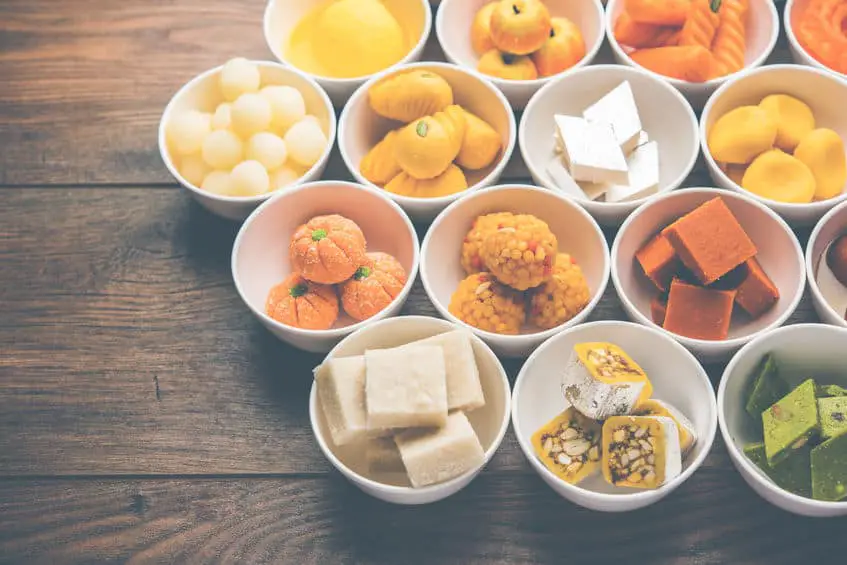
This is one food you won’t miss at a Hindu wedding because it’s just as, if not more, important than any chaat table or pile of naan. Mithai refers to a variety of sweets and not exactly just one. The sweets that account for mithai typically all consist of sugar and milk that is either baked, fried, or cooked.
Some popular types of mithai include, but are certainly not limited to, chikki, gulab jamun, and jalebi.
Burfi
A very popular type of mithai, burfi is just one of the many sweets often served at a Hindu wedding. With an unforgettable creamy, delightful flavor, burfi is a favorite enjoyed not just at weddings, but throughout the year.
Like much of the many varieties of mithai, burfi is made with sugar and milk and then baked.
“A common and versatile milk-based sweet, burfi is eaten year-round – especially at Diwali. It is made with condensed milk and sugar but can be flavored with fruit (such as coconut), nuts, or different types of flour.”
Source: The Big Fat Indian Wedding
Although burfi is a type of mithai sweet, it, too, comes in several types, including pista barfi (burfi), a pistachio-flavored variety, and even chocolate barfi. Yum!
To make this delectable treat in the comfort of your own home, visit here.
Payasam
Speaking of desserts, a Hindu wedding can never go wrong in serving up a traditional payasam. Payasam is an Indian rice pudding consisting of vermicelli rice, coconut milk, and a blend of sweet spices such as cardamom and cinnamon. This mixture is slowly simmered and stirred until it reaches the consistency of a pudding.
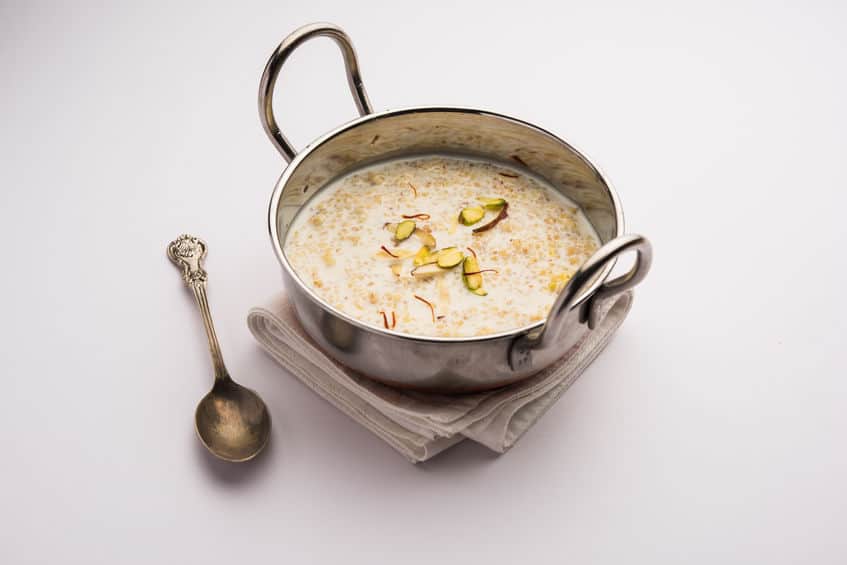
Also often referred to as kheer, payasam can be customized in many ways to include dried fruit such as raisins and dates, nuts, and shaved coconut.
Rasavalli
Rasavalli or rasabali is similar to payasam and is also another sweet dish that may be served at a Hindu wedding. It often consists of chhena, a type of cheese, or king yams (as an alternative) that is soaked in sweetened condensed milk.
Once the soaking has been completed, and the chhena or yams have absorbed the sweetened condensed milk, the dish is seasoned cardamom.
Curry
Even if you’re not familiar with much of the cuisines belonging to the Indian culture, at one point or another, it’s certainly possible you’ve heard of curry. Even in cultural cuisines outside of India, like Jamaica, for example, curry acts as a staple dish eaten for any and all occasions.
Whether it’s a North Indian Hindu, a South Indian, or simply, a Hindu wedding, there’s bound to be a curry of some kind there. Be sure to emphasize ‘some kind’ because there are literally just as many curry varieties as there are sabzis. From vegetarian and plant-based curries to meat and seafood curries, the list goes on.
There are so many types of curries that exist in the Indian culture, you could sustain a whole wedding party for the entirety of the wedding, three whole days to be exact, with just curry! In Indian cuisine, curry refers to a dish consisting of meat and vegetables or one or the other mixed together in a thick sauce or gravy with spices.
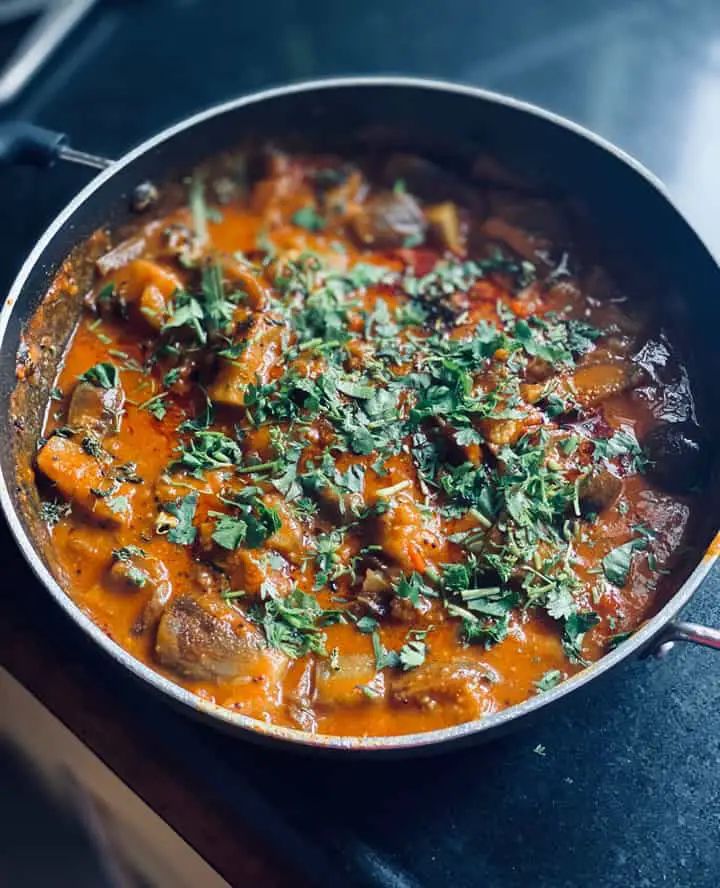
Garam masala is the blend of spices normally used in curry and includes spices such as curry powder, the main ingredient in curry, as well as mustard seed, ginger, and garlic, to name a few. Although garam masala refers to the spices used in curry, it differs slightly from curry powder. To understand the distinction between the two, click here.
Some types of curries include chicken curry, lentil curry, pumpkin curry, and lamb curry. One common misconception behind Indian cuisine is that much of it is spicy. However, this is not the case with all dishes, and especially curry. While some curries can be heavier on the spice compared to others, it ultimately depends on who makes it.
Don’t forget the Wedding cake
Mehndi often refers to the form of body art often practiced in Indian culture, especially for Hindu weddings in which the bride’s arms, hands, and feet are intricately adorned in henna ink. In the case of the Hindu wedding cake, it now also refers to the intricate design of the cake itself.
Wedding cakes are considered traditional in many cultures, but Hindu weddings take it to a whole other level with mehndi wedding cakes. Considering the wedding on its own is quite lavish, why not have the cake take part in this lavishness as well?
Mehndi cakes have become quite a trend and feature colorful designs and piping resembling that of mehndi body art. To get a look at what mehndi cakes are all about, visit here.
Foods That Don’t Do Well At A Hindu Wedding
Generally speaking, all foods relative to the culture typically will be a hit with the guests at a Hindu wedding. However, there is one particular mishap to avoid when serving food at a Hindu wedding. The general rule when deciding which food to serve at a Hindu wedding is to choose foods that don’t overlap with each other.
It’s custom to distinguish amongst foods whose flavors will not overlap in any way. For example, it would be considered uncustomary to serve lamb and chicken curry, considering these are pretty much the same dishes, just with different meats.
Likewise, the spread at a Hindu wedding is taken very seriously, and you certainly don’t want those lovely traditional Indian elders looking down at the two dishes that cancel each other out. Overall, if a Hindu wedding sticks to this rule and there’s at least one aloo dish at the table, it will be praised by all who attend.
